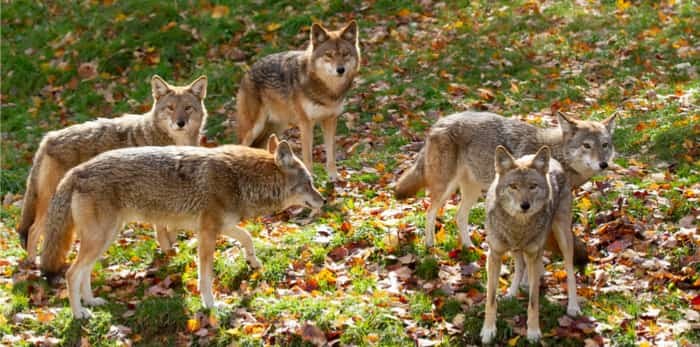 Coyotes (Canis latrans) standing in a grassy green field in the golden light of autumn in Canada / Shutterstock
Coyotes (Canis latrans) standing in a grassy green field in the golden light of autumn in Canada / Shutterstock
They are intelligent, adaptable, and intriguing, and most residents of the Lower Mainland have seen at least one - but coyotes are not native to Vancouver.
In fact, these wily predators are fairly new to the region, with the first canines appearing in the 1980s. Nevertheless, these opportunistic animals have managed to thrive, with the reporting an estimated 2,000 to 3,000 coyotes populating urban areas in the Lower Mainland. They are originally from desert ares in the United States, but have spread out across the continent, following urban growth.
And while they aren’t known to be especially dangerous, they do have a penchant for household pets, and many of our four-legged buddies become easy meals. With that being said, the SPCA notes that over 90 per cent of their diet consists of rodents, and Â鶹´«Ã½Ó³»is notorious for its rat population.
±õ³Ù’s and lots of lovely wildlife to watch on the marsh today - videos on my YouTube channel -
(subscribe too please 😊🙏♥️😘) 30 Jan 2019
— Pacificnorthwestkate (@pnwkate)
Coyotes in Vancouver
Â鶹´«Ã½Ó³» spoke to Madeleine Irving Chan, Urban Wildlife Programs Coordinator, Stanley Park Ecological Society, who explained how this lanky canine spread in the region, and what its rise means for residents.
"Coyotes weren't in the area until the 1980s, and they follow people. They are extremely opportunistic," she described.
"January through March has the highest number of sightings, as it is during their courting/mating season. Interestingly, coyotes mate for life, which is relatively uncommon in the canine world."
When asked about the increase in recent sightings in Mount Pleasant, Irving Chan notes that someone was feeding the animals.
"It is really sad, but we had a resident tell us that someone was feeding raccoons and the coyotes were eating it. As a result, they were losing their fear of people - this is typically how they become so comfortable."
Super casual visitor on my patio in Mount Pleasant
— Dara Fontein (@deefontein)
Irving Chan adds that although there were a number of concerning behaviours seen lately, none of the incidents were violent.
"Last year a child was brutally attacked by a coyote - nothing like that has happened this year. In fact, even in the incidents that were reported, none of them were snarling or flattening their ears. With that being said, there was one coyote that did not respond to the coyote shaker, which was an issue."
She explained that a coyote shaker is made by filling a pop can with coins and stones and shaking it to scare the animal away. Unfortunately, this animal did not respond to the noise, which was was indicative that it was unafraid.
If you see a coyote, scare it away by yelling, stamping your feet and waving your arms. Make lots of noise and try to look big. This may feel silly, but will help the coyote avoid future problems. Teach children how to scare away a coyote if they see one, but never throw anything at the animals.


